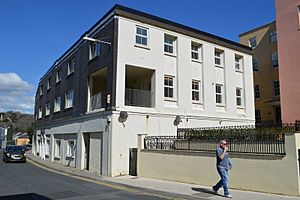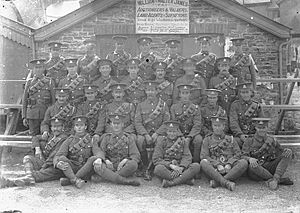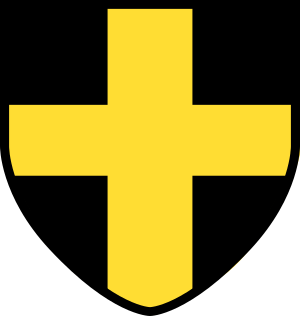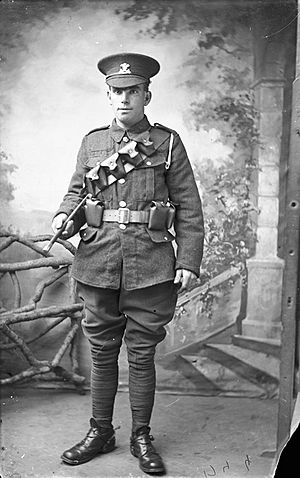Pembroke Yeomanry facts for kids
Quick facts for kids Pembroke Yeomanry |
|
|---|---|
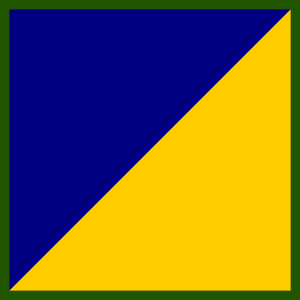
Tactical Recognition Flash (TRF) of the Royal Logistic Corps
|
|
| Active | 22 April 1794 – present |
| Country | |
| Branch | Yeomanry (World War I) Royal Artillery (World War II) Royal Logistic Corps (current) |
| Size | One Squadron |
| Engagements | |
The Pembroke Yeomanry was a special part of the British Army. It started way back in 1794. This group of soldiers fought in many big wars. These included the French Revolutionary War, the Second Boer War, World War I, and World War II. Today, its history is carried on by 224 (Pembroke Yeomanry) Transport Squadron. This squadron is part of 157 (Welsh) Regiment RLC in the Army Reserve.
Contents
Early Days: Forming the Pembroke Yeomanry
In 1794, Britain was fighting in the French Revolutionary Wars. The Prime Minister, William Pitt the Younger, suggested that counties should create volunteer cavalry. These groups were called Yeomanry. They would help defend the country from invasion. They could also help keep order if there were problems at home.
Lord Milford, a leader in Pembrokeshire, was one of the first to act. He helped create the Castlemartin Troop on April 22, 1794. This was one of the very first Yeomanry units. It was led by John Campbell. Soon after, the Pembroke Yeoman Cavalry was formed on July 17.
The French Revolutionary Wars
These early Yeomanry units were meant to serve mainly in Pembrokeshire. They could also go to nearby Carmarthenshire and Cardiganshire. They were ready to protect their local area.
The Battle of Fishguard: A Unique Victory
In February 1797, French ships were seen near the coast of Pembrokeshire. They were trying to invade Britain. The French landed near Fishguard on February 22. Their force was called the Légion Noire. It had about 1,300 soldiers, many of whom were former prisoners.
Lord Cawdor quickly gathered local forces. These included the Castlemartin Troop and other volunteers. Many local people also joined, some even with pitchforks! Welsh women in their traditional red shawls and tall black hats were also seen. From a distance, they looked like more red-coated soldiers.
The French commander, William Tate, saw all these people. He thought he was facing a much larger army. His own troops were also causing trouble, looting farms. So, Tate decided to surrender. The French gave up on Goodwick Sands. This event is known as the Battle of Fishguard. It was the last time an enemy force invaded Britain.
Because of their bravery, the Pembroke Yeomanry received a special honour. Queen Victoria gave them the battle honour Fishguard in 1853. It is the only unit in the British Army with an honour for a battle on British soil.
After the war, some Yeomanry units were temporarily stopped. But they were reformed when the war started again in 1803.
Serving the Empire: The Boer War
In 1899, Britain was fighting the Second Boer War in South Africa. The government needed more soldiers. They created the Imperial Yeomanry (IY). These were volunteer forces. The Pembroke Yeomanry formed the 30th (Pembrokeshire) Company. They arrived in South Africa in April 1900.
This company fought bravely. Their service earned the regiment another battle honour: South Africa, 1901. After the war, all Yeomanry regiments became Imperial Yeomanry. They were trained as mounted infantry, meaning they rode horses but fought on foot.
World War I: From Horses to Infantry
In 1908, the Imperial Yeomanry became part of the new Territorial Force (TF). The Pembroke Yeomanry was then organised into four squadrons. These squadrons were based in different towns. They were in Tenby, Haverfordwest, Carmarthen, and Lampeter.
Joining the Fight: 1st Line Yeomanry
When World War I began in August 1914, the Pembroke Yeomanry mobilised. They were part of the South Wales Mounted Brigade. Many soldiers volunteered to serve overseas.
The 1st Line Pembroke Yeomanry went to Egypt in 1916. A small group from the regiment even joined the Imperial Camel Corps. This was a special unit that rode camels!
Becoming Infantry: The Welsh Regiment
In March 1917, the 1st Line Pembroke Yeomanry changed roles. They became infantry soldiers. They joined with the Glamorgan Yeomanry. Together, they formed the 24th (Pembroke and Glamorgan Yeomanry) Battalion, Welsh Regiment.
This new battalion fought in the Sinai and Palestine campaign. They took part in important battles like the Third Battle of Gaza and the capture of Jerusalem. In May 1918, they moved to the Western Front in France. They fought in the Hundred Days Offensive, which helped end the war. The 24th Welch entered the town of Ath on November 11, 1918, just hours before the fighting stopped.
Home Front: 2nd and 3rd Line Units
Back home, a 2nd Line regiment was formed in 1914. This unit was for home defence. In 1916, many Yeomanry units became cyclists. The 2nd Line Pembroke Yeomanry also became a cyclist regiment for a time. A 3rd Line regiment was also formed to train new soldiers. These soldiers would replace those fighting overseas.
Between the Wars: Becoming Artillery
After World War I, the army realised it had too many cavalry units. So, many Yeomanry regiments changed roles. In 1920, the Pembroke Yeomanry became an artillery unit. It was renamed 102nd (Pembroke and Cardigan) Brigade, Royal Field Artillery.
This meant they now operated large guns instead of riding horses. In 1924, the Royal Field Artillery became part of the Royal Artillery. The unit's name changed to reflect this. They were equipped with 18-pounder guns and 4.5-inch howitzers. These were types of cannons used in World War I.
World War II: Global Conflicts
When World War II began in September 1939, the 102nd Regiment was ready. Another unit, the 146th Field Regiment, was also formed from the original regiment. Both were part of the 38th (Welsh) Infantry Division.
Defending Britain: Home Service
At first, these regiments trained in Wales. After the Dunkirk evacuation, they moved to defend areas like Liverpool and Sussex. They were ready to fight if Britain was invaded. As the threat of invasion lessened, these units helped train and supply soldiers for overseas.
Fighting in North Africa and Italy
The 102nd (Pembroke & Cardiganshire) Field Regiment went to North Africa in 1942. They fought in the Tunisian campaign. This included tough battles like 'Hunt's Gap'. After the fighting in Tunisia ended, the regiment stayed in North Africa.
In September 1943, the 102nd Regiment changed again. It became the 102nd (Pembroke Yeomanry) Medium Regiment. They then moved to Italy in December 1943. They fought with the Eighth Army in the Italian Campaign. They were involved in famous battles like Monte Cassino and breaking through the Gothic Line. By the end of the war, they were near the River Po.
The 146th (Pembroke & Cardiganshire) Field Regiment also went overseas. They landed in Egypt in September 1942. They joined the Eighth Army in the Western Desert Campaign. They fought in the Second Battle of El Alamein and other key battles in North Africa.
On the Western Front: Normandy and Beyond
The 146th Regiment was then chosen to become a medium artillery unit. It was renamed 146th (Pembroke & Cardiganshire) Medium Regiment. They returned to the UK to prepare for the Normandy landings.
The regiment landed in Normandy, France, in July 1944. They took part in major operations like Operation Goodwood and Operation Bluecoat. They helped support infantry divisions as the Allies pushed through France. They also played a role in clearing the Venlo 'Pocket' and crossing the Rhine River. After the war, the 146th Regiment was officially disbanded in 1947.
Modern Times: The Army Reserve
After World War II, the 102nd (Pembroke Yeomanry) Medium Regiment was reformed. It became 302 (Pembroke Yeomanry) Field Regiment in 1947. In 1961, the regiment changed its role again. It became a reconnaissance squadron in the Royal Armoured Corps. This meant they would scout ahead to gather information.
In 1967, the army reorganised. The regiment formed A (Pembroke Yeomanry) Company and A (Pembroke Yeomanry) Troop. These units were part of different regiments. In 1969, the troop joined to form a new squadron. This was the 224 (West Wales) Squadron.
In 1987, it was renamed 224 (Pembroke Yeomanry) Transport Squadron. In 1994, it became part of the Royal Logistic Corps (RLC). Today, 224 (Pembroke Yeomanry) Transport Squadron is still active. It is part of 157 (Welsh) Regiment RLC in the Army Reserve.
Special Traditions: Uniforms and Honours
Looking the Part: Uniforms and Badges
Over the years, the Pembroke Yeomanry wore many different uniforms. In 1850, they dressed like Hussars, with blue jackets and special lace. They wore a black Shako hat. Before the Boer War, they wore dark blue jackets with white trim and a fur Busby hat.
During World War I, they wore the standard khaki service dress. This was a practical uniform for fighting. After World War II, they wore battledress and other standard British Army uniforms.
The regiment had a special cap badge. It showed the Prince of Wales's feathers and the motto 'Ich Dien'. Below it was a scroll with their unique battle honour, 'Fishguard'. Even when they became artillery, they kept this badge as a collar badge. This led to the 146th Regiment being nicknamed 'Fishguard Express'.
Proud Achievements: Battle Honours
The Pembroke Yeomanry earned many battle honours for their bravery. These are special awards for fighting in important battles.
- Fishguard (French Revolutionary War)
- South Africa, 1901 (Second Boer War)
- For World War I, they earned honours like: Somme 1918, Bapaume 1918, Hindenburg Line, Épehy, Pursuit to Mons, France & Flanders, 1918, Egypt, 1916–17, Gaza, Jerusalem, Jericho, Tell 'Asur, Palestine, 1917–18.
The Royal Artillery does not usually receive battle honours. Their motto, Ubique (meaning 'Everywhere'), covers all their actions. So, the regiment did not receive specific battle honours for World War II.
In 1946, the Pembroke Yeomanry received the Freedom of the Town of Haverfordwest. This is a special honour given by a town to a military unit. In 1997, 224 Squadron received the Freedom of Fishguard and Goodwick. This was to mark 200 years since the Battle of Fishguard.
See also
- Imperial Yeomanry
- List of Yeomanry Regiments 1908
- Yeomanry
- Yeomanry order of precedence
- British yeomanry during the First World War
- Second line yeomanry regiments of the British Army
- List of British Army Yeomanry Regiments converted to Royal Artillery





